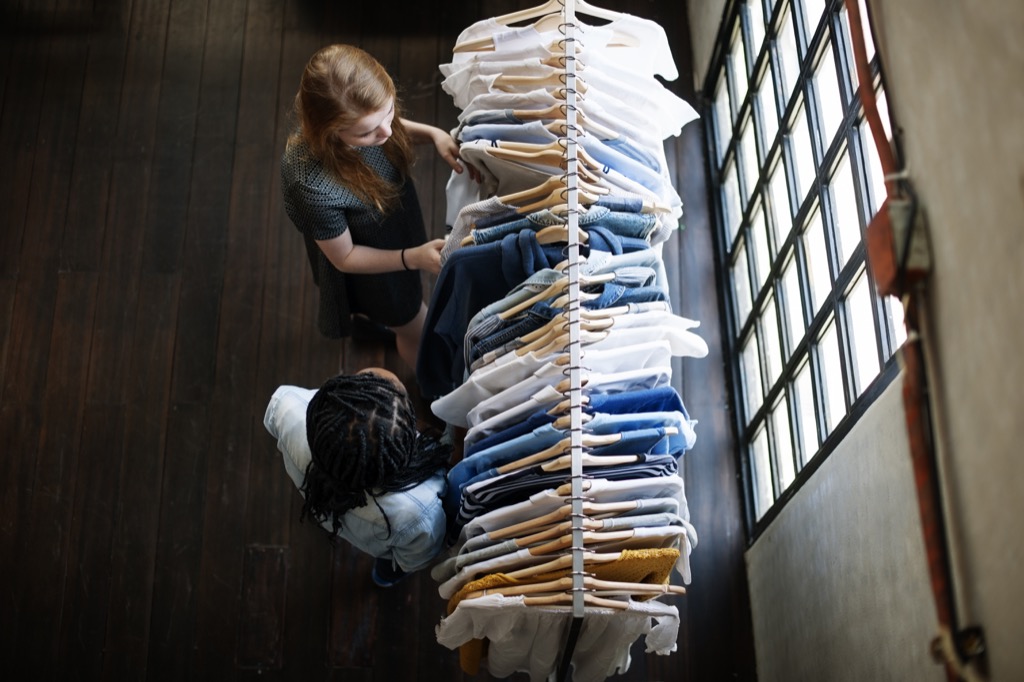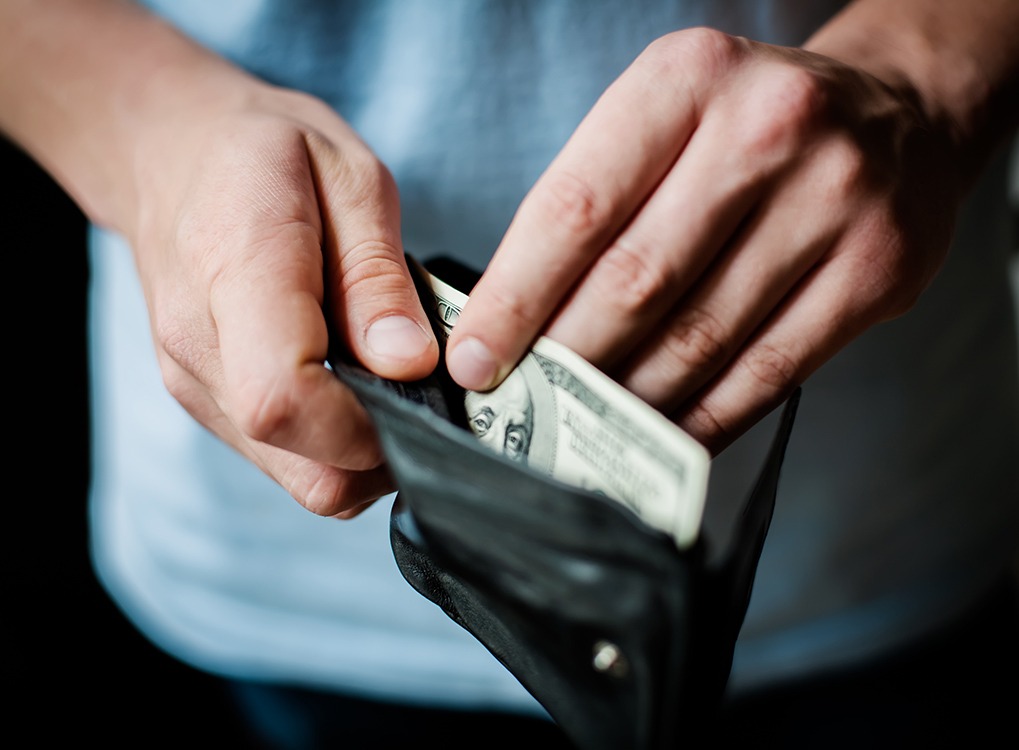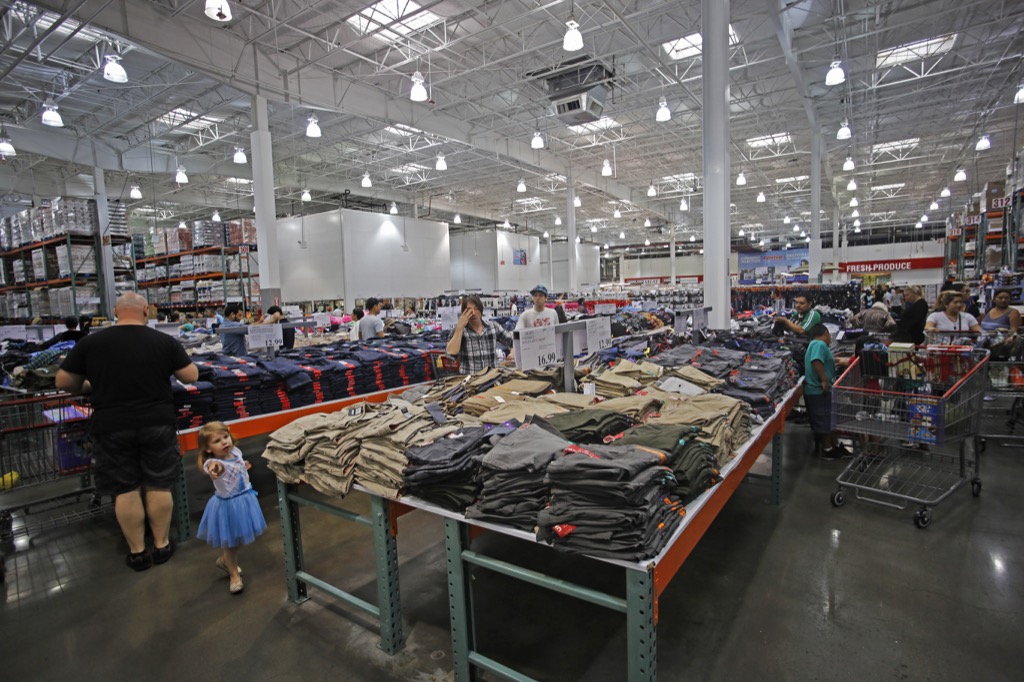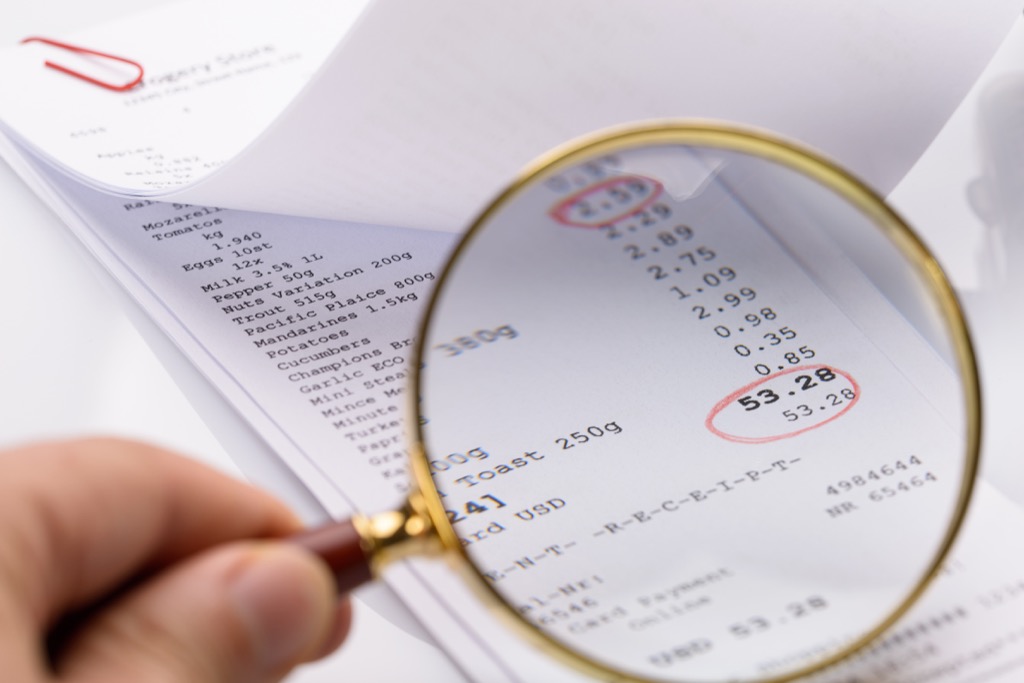30 Genius Tricks for Never Paying Full Price on Clothes
Look like you spent the big bucks without breaking the bank.

Whether it's saving on a suit or cutting costs on an amazing pair of shoes, you should never, ever, pay full price for any item of clothing. (Believe me, as veteran shopping expert, I know.) Now, if you're not sure how, I've included here the 30 best insider tricks to ensure you haggle, negotiate, trick, or simply score a better deal every single time you either step foot into a store or shop for an item online. So read on, and enjoy your new wardrobe!
1
Steer clear of the center of the store

There's pricey psychology at work when it comes to where that sweater will be displayed in store. Since it's human nature to stride in and head for the center, that's where pricier items or ones with higher margins will usually be showcased.
So what are the dead zones you should gravitate to for better savings?
Immediately to the left of the entrance (since 19 out of 20 people are right-handed, we tend to veer right), and the extreme rear of the store (many won't make it that far). These are the two places promos will often be located to help drive foot traffic.
2
Cash in on local loyalty

Check which big name brands are headquartered near your home. They'll likely hold employee-aimed discount or warehouse sales at local facilities that will often be opened up to the community as a gesture of goodwill. Spot them, and you're guaranteed to save loads of moolah.
3
Buy in bulk

Target your purchases to a small number of stores and group them. Pick up a pair of jeans, and find a sales associate—tell them you'd like to buy another pair, but only if there's a discount available. Trust me: they'll likely find a way to slash 10% off to close that sale.
4
Shop with a paid pal

Personal shoppers usually receive a discount from stores as a lure to help bring clients in store (it's usually 10-20% off the retail price). Find one in your town (the listings at the Association of Image Consultants International are reliable), and agree in advance that he or she will pass along that discount directly to you. Sure, you'll pay for their time, but if you buy strategically—occasionally, and in bulk—you'll still save overall.
5
Know the best time to buy

Sales are carefully planned. In general, once an item has lingered in store for 6 weeks, whatever remains will be discounted on the 43rd day: if you've found something you love, watch it until that window expires. And for more amazing shopping advice, see these 27 Amazing Amazon-Branded Products You'd Never Think to Buy But Should.
6
Take advantage of friendly savings

Like a store? Well, be sure to buy from only one person at the shop—learn their name, ask for them when you shop, and make sure to check their schedule. After all, they're on commission most of the time, and a regular buyer is a reliable income source.
Once you're recognized, that friendly sales associate can invite you to the pre-sale period—that week before the sale signs go up when insiders can shop at discounted prices in secret—and include you in friends and family promo periods.
7
Stay well adjusted

Many retailers offer price adjustments, where you can claim a refund if the item you've bought is marked down within a certain timeframe afterwards—Banana Republic, for example, has a 14-day price adjustment policy, while J. Crew allows you 7 days grace. Save your receipt, and keep a close eye on the price of whatever you've bought.
8
Hack the price codes

Retailers use a combination of algebra and alchemy to come up with the prices they charge. In general, though, any price that ends in a number other than 9 or 0 will be at a deep discount—exact practices vary from store to store, but you can use this chart to check your faves.
9
Pay with cash whenever humanly possible

Ask for a discount in exchange for saving a store the 3-5% it pays on card transactions. Research has also shown that people will spend significantly more, up to twice as much, if paying with a credit card versus cash, so a greenback-only approach will also help you stick to a budget.
10
Hit the outlet malls

Duh! But remember: if you're shopping there, shop with caution.
Here are my two pieces of advice when outlet-mall shopping: 1) Know that most items at outlet stores feature two prices: a high one and then the discount one. If the higher price is flagged anything other than "ORIGINAL PRICE" (two red flags are "COMPARED TO" or "RETAIL VALUE"), you're probably holding merchandise made especially for the outlet, so it's a lesser quality good. And 2) Remember to pay cash, which means you'll be able to ask the cashier for a discount in exchange for saving the store the 3-5% it pays on card transactions. Voila! Instant savings!
11
Tease the retailer online.

If there's anything that online retailers hate, it's abandoned carts—almost 7 in 10 purchases aren't completed at web stores, as the shopper is distracted by a doorbell or simply gets cold feet and can't hit the "purchase" button.
In response, the store will often send follow up emails containing discount codes as a nudge to remind a shopper about that forgotten cart. So, if you practice the art of abandoning your card your deliberately at the altar, there's a good chance you'll receive some sweet promo codes shortly thereafter. Genius, right?
12
Use Paribus

Sign up for Paribus, an entirely free, automated service that will request a price-adjustment if an item you've bought online is later discounted. It safely scans your email inbox for receipts and then monitors prices for those items. Paribus works with many online retailers, including Newegg, Nordstrom and Bed, Bath & Beyond.
13
Buy direct

Companies that don't sell to stores but rather directly to consumers can cut out the middleman and pass on the money saved as a discount. Take Everlane, which makes men's and women's tops and accessories. It explains its pricing, showing how it can charge $15 for a T-shirt that could cost $60 or more at a traditional shop.
Project Gravitas is based on a similar concept. It sells stylish, American-made Victoria Beckham-like sheath dresses with built-in Spanx-like shapewear that could cost $800 or more in a department store for around $300.
14
Make it personal

Personal shopping sites like Shop It To Me and ShopStyle allow you to pick brands or stores you like and will monitor whatever you've indicated until it goes on sale. Once the price is slashed, you'll receive an email alerting you to a deal tailor-made to your interests.
15
Go for secondhand gift cards

Gift Card Granny and Cardpool act as marketplaces where users can offload unwanted gift cards, usually selling for around 10-15% lower than the face value. If you know what you want to buy and where, you can snap up a gift card here and you've already secured your own personal 15% promo!
16
Subscribe and save

Sign up for emails from any store where you shop regularly. Yep, you'll have to wade through some spam, but you'll also likely receive subscriber-only promo codes to use online or in the store.
17
Shop off-season

The cheapest way to buy a great winter coat is to snap it up when it's 100 degrees or more outside—and bikinis will be bargains in a snowstorm. Regular stores, of course, won't have them in stock, but you can usually find out of season items on sale at a store's online outlet.
18
Navigate the Amazon

Install the CamelCamelCamel browser extension, which is a superb Amazon price tracker. It will not only show you a history of whatever Amazon charged for any item on the site, but will also allow you to create an alert so you'll receive an email the instant that item hits your desired (discount) price.
19
Start with a deal

Ebates is a discount shopping portal. Start browsing here, and you'll automatically earn extra cash back on purchases at many major online stores as long as you click through to that store from the relevant page at Ebates. The standard cashback is 3%, but there will be regular promos that double that; occasionally, you'll even be offered a 20% cashback on purchases.
20
Consign of the times

Don't buy designer labels brand new—opt for barely used items via certified resale sites like The Real Real and Material World. These online marketplaces sell top quality items, usually from last season, for a fraction of their retail cost. You can even trade in items from your own closet for cash to spend there.
21
Beware Dry Clean Only

Squint carefully at the care tag inside every piece of clothing. Dry Clean Only items, even on sale, aren't cheap in the long run—cleaning them will quickly add up. If it just recommends Dry Clean, don't worry; that's a shifty move by manufacturers, and you can usually hand wash at home.
22
Give credit

Log into your American Express account online, and you'll see regular offers, customized per your spending, which can be added to your card—$50 off a $200 spend, for example, at a specific store.
Make sure to check these monthly, and add them to your card, as they provide automated discounts. Many other credit cards offer similar opt-in promos, or cash back on purchases. (Citi Double Cash, for example, gives a 2% rebate with no limit.)
23
Stay basic

Buy basics like white t-shirts in bulk at stores like Costco or Sam's Club. The quality is often much higher than you'd expect, since the enormous volumes produced allow them to maintain margins even if the retail price is lower than the mall.
24
Practice price matching

There are too many shops and not enough shoppers, so they're fighting for every dollar we spend. If you find an item you like at a lower price elsewhere, take a photo of that lower price then use it as leverage—ask politely if a rival store will match it. This works equally whether you're sitting at home on your laptop or standing in store, checking via apps like PriceGrabber on your smartphone.
25
Shop the kids' aisle

Check the kids' department, whatever your shape or size. Accessories like hats and scarves will be cheaper, and fit almost anyone; you'll often be able to pick up basics like T-shirts, too.
26
Master all you survey

Receipts, both printed and digital, will often feature a URL at the bottom where you can take a survey and provide feedback on your experience. As an incentive, many retailers will gift you a 5% or 10% discount on your next purchase for the two minutes or so of your time that survey will take.
27
Capitalize on the "care discount"

If you look after whatever you've already bought, you'll save in the long run. The two best value upgrades? Swap out wire hangers for wooden or plastic ones, which will be gentler on shoulders and less likely to snare and stretch, and invest in mothballs or cedar spray to keep moths at bay. And if you clean your sweaters before you store them, you're increase their lifespan.
28
Know that size matters

Know your size: Keep a record of the size you wear in any brand close at hand. Deeply discounted items online won't be able to be returned, so you need to make sure they'll fit or that deal is a waste of money.
29
Swap it up

If you really don't want to spend a cent, rally a few pals and pool the clothes each of you doesn't want; that swapping party is a free way to refresh your closet.
30
Mark your calendar

Steer clear of April and October, which are the least discounted months of the year. In April, we feel wealthier because of that fat tax refund—and stores take advantage accordingly by resisting discounting.
October is the last chance stores will have to sell holiday merch at full price, before Black Friday kicks off discount season.
Mark Ellwood is author of Bargain Fever: How to Shop in a Discounted World
To discover more amazing secrets about living your best life, click here to sign up for our FREE daily newsletter!





















